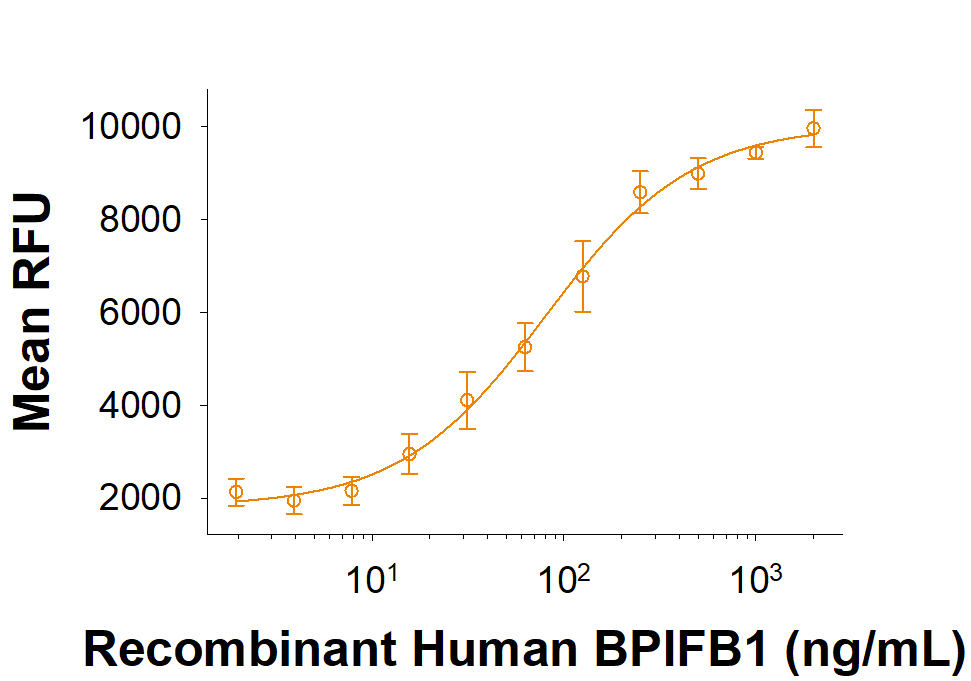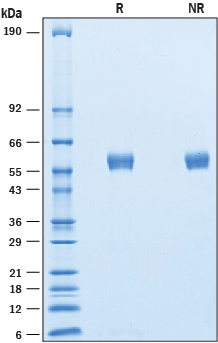Recombinant Human BPIFB1 His-tag Protein, CF Summary
Product Specifications
Thr22-Gln484, with a C-terminal 6-His tag
Analysis
Product Datasheets
Carrier Free
CF stands for Carrier Free (CF). We typically add Bovine Serum Albumin (BSA) as a carrier protein to our recombinant proteins. Adding a carrier protein enhances protein stability, increases shelf-life, and allows the recombinant protein to be stored at a more dilute concentration. The carrier free version does not contain BSA.
In general, we advise purchasing the recombinant protein with BSA for use in cell or tissue culture, or as an ELISA standard. In contrast, the carrier free protein is recommended for applications, in which the presence of BSA could interfere.
10195-BF
| Formulation | Lyophilized from a 0.2 μm filtered solution in PBS. |
| Reconstitution | Reconstitute at 500 μg/mL in PBS. |
| Shipping | The product is shipped at ambient temperature. Upon receipt, store it immediately at the temperature recommended below. |
| Stability & Storage: | Use a manual defrost freezer and avoid repeated freeze-thaw cycles.
|
Scientific Data
 View Larger
View Larger
Recombinant Human BPIFB1 His-tag binds to fluorescein-conjugatedE. coliBioparticles. The ED50 for this effect is 30-240 ng/mL.
 View Larger
View Larger
2 μg/lane of Recombinant Human BPIFB1 His-tag was resolved with SDS-PAGE under reducing (R) and non-reducing (NR) conditions and visualized by Coomassie® blue staining, showing bands at 55-61 kDa.
Reconstitution Calculator
Background: BPIFB1
BPIFB1 (BPI fold-containing family B member 1), also named LPLUNC1, is a member of the BPI-fold (BPIF) containing/Plunc (palate, lung, and nasal epithelium clone) superfamily of putative innate defense molecules which are predominantly expressed in regions of the oral cavity, nasopharynx and upper respiratory tract (1, 2). BPIF proteins exist as two subgroups, BPIFA (formally SPLUNCs) and BPIFB (formally LPLUNCs) (1, 3). BPIFA proteins have structural homology to the N-terminal domain of BPI whereas BPIFB proteins have structural homology to both domains of BPI (2). Human BPIFB1 cDNA encodes a 484 amino acid (aa) precursor protein with a putative 21 aa signal peptide and a 463 aa mature chain. The mature human BPIFB1 shares approximately 57% and 56% aa sequence identity with mouse and rat BPIFB1, respectively. BPIF proteins appear to exhibit distinct tissue and cell specific expression patterns with various family members, being localized to a number of glandular structures within the upper respiratory tract, nasopharyngeal regions and oral cavity where they are secreted from these tissues and are found in high levels in saliva and nasal and respiratory lining fluids (2). BPIFB1 plays a role in diverse functions, including neutralizing endotoxin (LPS) in septic shock patients, inhibition of endothelial cell growth, dendritic cell maturation, as an anti-angiogenic, chemoattractant or opsonization agent (2). Although less characterized as BPIFA1, BPIFB1 may also function as an innate immune molecule sensing and responding to Gram-negative bacteria (4). BPIFA1 and BPIFB1 expression was increased in late stage chronic obstructive pulmonary disease (COPD) patients, and elevated levels correlate with disease severity (5). BPIFB1 is also upregulated in cystic fibrosis (CF) lung disease and may play a role in the pathogenesis of the disease (6).
- Bingle, C. D. and C. J. Craven (2002) Hum. Mol. Genet. 11:937.
- Alves, D. B. et al. (2017) Braz. Oral Res. 31:e6.
- Bingle, L. et al. (2012) Histochem. Cell Biol. 138:749.
- Balakrishnan, A. et al. (2013) Innate Immun. 19:339.
- De Smet, E. G. et al. (2017) Int. J. Chron. Obstruct. Pulmon. Dis. 13:11.
- Saferali, A. et al. (2015) Am. J. Respir. Cell. Mol. Biol. 53:607.
FAQs
No product specific FAQs exist for this product, however you may
View all Proteins and Enzyme FAQsReviews for Recombinant Human BPIFB1 His-tag Protein, CF
There are currently no reviews for this product. Be the first to review Recombinant Human BPIFB1 His-tag Protein, CF and earn rewards!
Have you used Recombinant Human BPIFB1 His-tag Protein, CF?
Submit a review and receive an Amazon gift card.
$25/€18/£15/$25CAN/¥75 Yuan/¥1250 Yen for a review with an image
$10/€7/£6/$10 CAD/¥70 Yuan/¥1110 Yen for a review without an image
